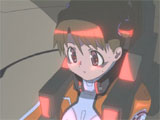

Quick Links:
Stellvia (Uchuu no Stellvia), Volume 1: Foundation I
The category of post-apocalypse stories is well-traveled territory in anime. These stories typically begin in the wake of some natural, man-made, or wartime cataclysm, and chronicle humanity's struggle to survive - while at a significant disadvantage than before. That disadvantage is usually the driving force of these stories, forcing the remaining humans to unify and amend their ways to survive. At its outset, Stellvia is missing one of the key ingredients of the formula. It begins far after the disaster, in a time where humans have bounced back tremendously and are living rather well. By omitting the grim aftermath and subsequent daily struggle to continue living, this series is poised to tell a different kind of story; one where a strong human race overcomes all obstacles and achieves prosperity.
Stellvia begins 186 years after a natural disaster from the cosmos. A shockwave of electromagnetic energy from a nearby supernova struck the planet, killing millions. In the present day, humanity has unified to combat the upcoming second wave of destruction from the dead star - this one containing not just energy but actual matter. As the series opens, they seem to be pretty well on top of things. Six space stations (called "foundations") have been created for the purpose of erecting a barricade to deflect the oncoming wave. We learn about life on Foundation II, a.k.a. "Stellvia," through Shima Katase, a newly accepted pilot student with a knack for programming - but not piloting.
Her piloting skills are so bad, in fact, that she gets into a lot of trouble from the start. She makes a few friends through it all, though, and the higher-ups at the Academy take notice of her extraordinary programming skills. The first few episodes let us get to know her and her friends a bit, and learn about the plan to save Earth. The story could go in a number of directions at this point. It will be interesting to find out whether the writers will continue showing a cooperative spirit between the Foundations, or if they will throw a little politics into the mix. The possibilities inherent with Shima and the other characters make the show worth continuing, despite the fact that it hasn't thrown us viewers any juicy bait yet.
Stellvia delivers a handful when it comes to the theme music, though. Both the opening and ending sequences feature songs by Angela (which is actually a group name; the singer's name is Atsuko). The opening song is Brilliant Road to Tomorrow, a song that makes you feel like you're sitting down to one of Sunrise's teen-angst space dramas. Atsuko's voice is strong and forceful, and impossible to ignore. The opening sequence is featured with the text shaven off, as the disc's only extra. The first ending theme song for the show is Beautiful Night Sky, which has a "fun with friends" feel. Even though the show itself isn't drumming up much excitement yet, at least the first and last couple minutes of each episode do.
Stellvia plays to young girls (I think), and as such, may not appeal to everyone. Shima's mannerisms are very cute, though, and probably will remain amusing for several episodes. That and a few other quirks may give Stellvia a more general appeal as the story develops. We will have to wait and see whether the show goes anywhere with its interesting premise, but I like what I see so far.
Distributor: Geneon Entertainment Creator: Ryo Akizuki / XEBEC Released: 2003
Video Quality: A Audio Quality: A Presentation: A- Content: B+ Overall: A-



